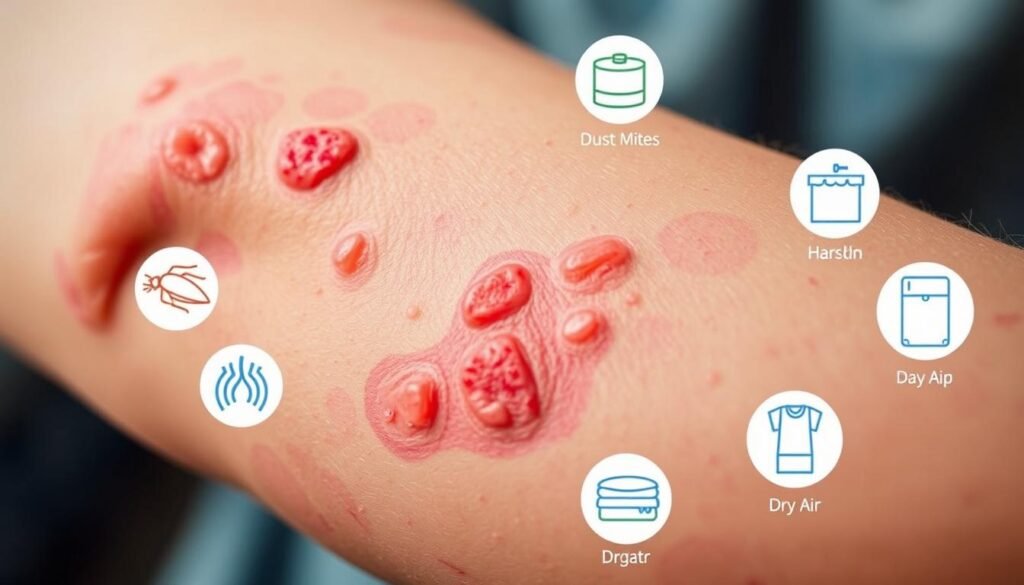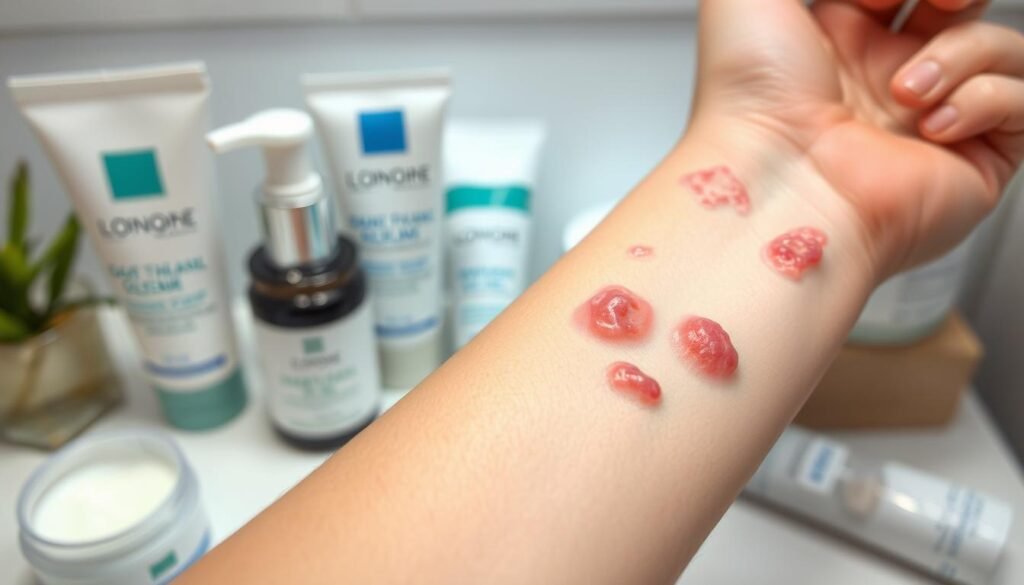Over 31 million people in the US suffer from eczema. The most common type is atopic dermatitis, which causes annoying bumps on elbows. This guide will help you understand how to treat these bumps by knowing more about eczema and the treatments available.
Dealing with eczema’s itch or finding the right treatment can be tough. But there is hope. This section will cover what causes eczema, its symptoms, and how to manage it. By the end, you’ll know how to improve your skin health.
Key Takeaways
- Understanding the specific type of eczema is crucial for effective treatment.
- Moisturizing regularly can significantly reduce symptoms.
- Self-care strategies play a vital role in preventing flare-ups.
- Identifying triggers helps manage and avoid skin flare-ups.
- Consulting with a healthcare professional ensures a tailored treatment plan.
- Stress management can positively impact skin health.
Understanding Eczema and Its Symptoms
Eczema is a chronic skin condition that affects many people in the U.S. It causes itchy skin, dryness, and inflammation in over 40 million Americans. The rash can show up in various places, especially where the skin bends, like elbows and knees.
People with eczema may see red, swollen skin, blisters, and feel intense itching. It often starts in kids aged two to adolescence, appearing in skin folds. Adults have similar symptoms, which may continue affecting their life and mental health.
Atopic dermatitis is the most common type, starting in babies or young children. While many kids outgrow it, some deal with it into adulthood. Knowing about eczema and what triggers it is crucial for managing it well. Treatments can include medicine, light therapy, and using moisturizers.
| Symptom | Description |
|---|---|
| Dry Skin | Skin lacks moisture leading to flaking and discomfort. |
| Itchy Skin | Persistent itching that may worsen with irritation or dryness. |
| Redness | Inflammation causing visible red patches on the skin. |
| Skin Rash | Patchy outbreaks that can vary in severity and location. |
| Blistering | Fluid-filled bumps that can become painful if scratched. |
Understanding these symptoms is key to managing eczema well. With the right knowledge and support, people can enjoy life despite this skin condition.
What Are Eczema Bumps on Elbows?
Eczema bumps on elbows are small, raised lesions. They are a sign of a condition called eczema or atopic dermatitis. The bumps can be crusty and may leak fluid if scratched. This shows the skin’s protective layer is damaged. Knowing about these bumps helps in treating and soothing the eczema rash.
Characteristics of Eczema Bumps
These bumps might look like tiny blisters and can be red and itchy. They have some specific features:
- Raised appearance: They appear as small raised spots on the skin.
- Crusty lesions: The surface can become crusty from skin damage.
- Fluid leakage: They might leak fluid if you scratch them, making things worse.
Common Locations of Eczema Rash
Eczema often shows up inside the elbows or behind the knees. These spots tend to have dry, sensitive skin, making them eczema hotspots. Knowing these common places helps catch symptoms early for quicker care. To learn more about spotting and tackling symptoms, check out this resource.
Types of Eczema: Focusing on Atopic Dermatitis
Atopic dermatitis is the most common form of eczema, affecting over 7% of adults in the U.S. It usually starts in childhood, often before turning five. The condition can show up anywhere on the body. Atopic dermatitis is known for causing a red, itchy rash in places like the elbows and knees. This condition can greatly affect someone’s life, especially when it gets worse due to certain triggers.
People with atopic dermatitis often have a family history of allergies or asthma. This points to a strong genetic factor. Their skin barrier doesn’t work as it should, making them more sensitive to things in their environment. Kids with eczema are likelier to face problems like anxiety, depression, or ADHD than kids without it. Doctors stress that treatment needs to be customized based on how severe the condition is and its effects on the person.
To manage atopic dermatitis, keeping the skin moisturized and using topical steroids are common approaches. Unlike contact dermatitis, which happens because of reactions to specific substances, atopic dermatitis requires broader strategies for relief and control. For more details on eczema types, consulting reliable sources is helpful.

Causes and Triggers of Eczema Flare-Ups
Understanding what causes eczema flare-ups is key to manage it well. Many environmental factors impact how often and how severe symptoms are. Knowing these can help people adjust their lifestyle and surroundings.
Environmental Triggers
Environmental triggers are a big factor in eczema flare-ups. Things that can irritate the skin include:
- Pollen
- Dust mites
- Pet dander
- Extreme temperatures
- Humidity levels
Weather changes, like cold or dampness, can make skin irritation worse. Household chemicals can also be a problem. It’s important to know these triggers to avoid them and keep symptoms in check.
Food Allergies and Sensitivities
Food allergies might lead to eczema flare-ups too. Some foods can cause more inflammation and skin trouble. Among these are:
- Dairy products
- Eggs
- Wheat
- Shellfish
- Nuts
Finding out if you have food allergies or sensitivities is a big step in managing eczema. A food diary or talking with a healthcare provider can reveal dietary triggers. Knowing about both environmental triggers and food sensitivities is crucial. This knowledge helps prevent eczema flare-ups. For more details, check out this resource.

Diagnosis of Eczema: When to See a Doctor
Knowing when to get medical advice for eczema is key. Many kids and teens get eczema. Often, it runs in families because of genetics. Spotting atopic dermatitis symptoms early helps a lot.
A doctor will check the rash and symptoms closely. They’ll ask about your health and your family’s. There’s no single test for eczema. The doctor uses what they see and know. A family history of eczema makes the diagnosis more likely.
Watch kids for signs of complications. Eczema might come with asthma or hay fever. Treating these can ease eczema too. Look out for infection signs, as eczema kids are at higher risk.
Knowing when to see a doctor is important. Skin infections are serious. If the skin is warm, red, or if there’s fever or lots of pain, see a doctor fast. Regular check-ups can change treatments if needed. Eczema can get better as kids grow. Yet, some deal with it into adulthood.

Topical Eczema Remedies for Quick Relief
Finding the right treatment for eczema can help ease discomfort. There are many options, from simple creams to strong prescriptions. Knowing about these choices helps people make smart decisions for their skin care.
Over-the-Counter Creams and Ointments
Many start with over-the-counter creams for eczema relief. These products often contain hydrocortisone, which reduces inflammation and itching. They can also lessen redness.
- Coconut Oil: Its quick absorption helps repair the skin barrier.
- Sunflower Oil: It locks in moisture and eases itchiness, great for babies.
- Colloidal Oatmeal: Found in lotions, it offers anti-inflammatory benefits.
These remedies are soothing. They’re good for managing mild symptoms every day.
Prescription Treatments for Severe Cases
Severe eczema might need prescription treatments. Doctors prescribe medicines like topical calcineurin inhibitors or biologics for chronic conditions. These focus on the inflammation pathways to improve the skin. Doctors often advise:
- Topical Calcineurin Inhibitors: These control flare-ups without steroid side effects.
- Biologics: For tough cases, biologics can offer relief when other treatments fail.
It’s important to talk with a doctor. They help you find the safest and most effective treatment for your eczema.
| Treatment Type | Examples | Use Case |
|---|---|---|
| Over-the-Counter Creams | Hydrocortisone, Coconut Oil, Sunflower Oil | For mild to moderate eczema relief |
| Prescription Treatments | Topical Calcineurin Inhibitors, Biologics | For severe, chronic eczema cases |
Knowing the different topical eczema remedies helps in choosing the right treatment plan.
Home Remedies for Eczema Bumps on Elbows
Finding the right home remedies for eczema on elbows is key. Regular use of moisturizers is vital for better skin. Also, the right bathing habits can keep skin healthy and minimize eczema flare-ups.
Moisturizing Techniques
Moisturizing regularly is crucial for easing eczema. Natural oils, like sunflower seed oil, help reduce itchiness and fix skin barriers. Coconut oil is great for lessening dryness and skin irritation. Using unscented moisturizers often, such as petroleum jelly, locks in moisture for healthier skin.
Colloidal oatmeal baths are excellent for soothing inflamed skin. They relieve skin irritation from eczema. To avoid skin irritation, use mild soaps and gentle cleansing methods in your bathing routine.
Importance of a Bathing Routine
A good bathing routine is essential for those with eczema. Baths should avoid drying out the skin. Adding 2 cups of vinegar to warm bathwater may help, according to the National Eczema Association. Putting 1/4 to 1/2 cup of bleach in bathwater could also ease eczema by reducing itch and irritation.
Cool compresses provide extra relief, especially after moisturizing. Taking regular, gentle baths helps keep skin moist. This is beneficial for people dealing with eczema.
Long-Term Management: Preventing Eczema Flare-Ups
Managing eczema for a long time is key to less flare-ups and healthier skin. Making lifestyle changes is very helpful. Knowing what causes your flare-ups, following a skincare routine, and changing daily habits are important steps.
Implementing Lifestyle Changes
To avoid eczema flare-ups, it’s important to change some parts of your life. Things to think about include:
- Maintaining a cool, humid environment at home.
- Wearing loose, breathable clothing to minimize irritation.
- Staying hydrated and eating a balanced diet that supports skin health.
- Keeping a symptom diary to identify potential flare-up triggers.
These steps can make your skin feel better. To learn about more ways to treat eczema, check out personalized treatment options online.
Stress Management Techniques
Managing stress is key to control eczema. Ways to reduce stress include:
- Practicing mindfulness or meditation daily.
- Engaging in regular physical exercise.
- Developing a supportive network of friends and family.
- Utilizing deep breathing exercises during stressful situations.
Looking after your emotional health helps your skin and makes life better. Knowing how stress and eczema connect shows why a full-care approach is important. For more on treating eczema, including recommended topical treatments that help both body and mind, go online.
Conclusion
Understanding and dealing with eczema bumps on elbows is crucial. Around 31.6 million Americans face eczema, making good management essential. Despite no cure for atopic dermatitis, knowing what triggers it and using the right treatments can bring a lot of relief.
Those affected should use effective treatments, like the FDA-approved dupilumab and topical therapies. It helps to use gentle soaps and humidifiers too. This keeps the skin moist and prevents eczema from getting worse. It’s worth noting that kids might outgrow eczema, but adults can still have dry or sensitive skin. This means they need to keep caring for their skin.
Being proactive in managing eczema helps people cope better with its challenges. By changing some lifestyle habits and seeking the right treatments, individuals can feel more in control. This leads to better skin health and a happier life.